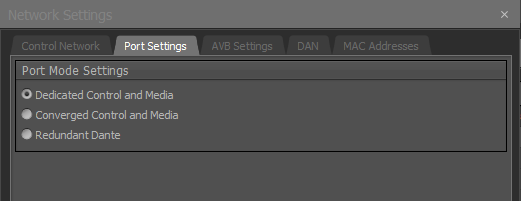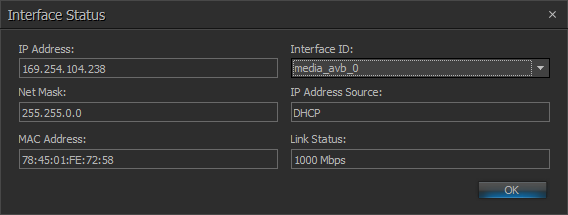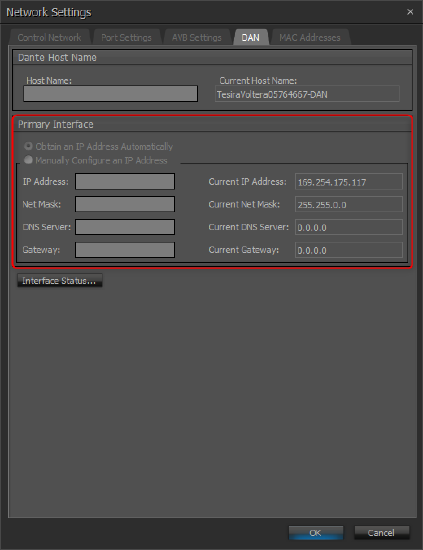Voltera D and D M Networking in Tesira
Voltera D and D M models support analog inputs for local audio sources. However, device discovery and configuration are managed over a standard IP network connection. When configured using Tesira software, they also support systems based around AVB, Dante, and AES67 network media transport. This resource provides additional detail about the network configuration and behavior of Voltera D and D M.
Please note: This article refers to "Voltera D" to include both the D and D M variants. D and D M amplifiers are functionally the same from a network standpoint. The Voltera D M differs in that it includes the full performance of a standalone DSP on top of the loudspeaker processing already included with the D models.
Port settings and supported topologies
Voltera D has two 1000BASE-T network ports labeled 1 and 2. The services available on each are dependent on the device configuration of the software. There are 3 port modes supported by Voltera D. These are configured in Tesira software from Device Maintenance > Network Settings > Port Settings.

| Port Mode Setting | P1 | P2 |
|---|---|---|
| Dedicated Control and Media | Control | Media (AVB/Dante) |
| Converged Control and Media | Control + Media (AVB/Dante) | N/A |
| Redundant Dante | Control + Primary Dante | Secondary Dante |
Dedicated Control and Media
This is the default port mode for Voltera D. Dedicated Control and Media requires that P1 and P2 are connected to different networks and configured with IP addresses in different subnets from each other.

P1 Control
In this Dedicated Control and Media example, P1 hosts the control interface. This is connected to a Tesira control network and is assigned an IP address from a DHCP server.

P2 Media
P2 hosts both the AVB and Dante interfaces. This port is connected to a separate AVB/Dante media network. Configured for DHCP, but with no DHCP server present, they both resolve to an address using APIPA. This satisfies the IP addressing requirements for Dedicated Control and Media.


Converged Control and Media
When this port mode is applied, control, AVB, and Dante are all available on P1 of the Voltera D. P2 is unused and should remain link down. In this configuration, all interfaces will have an IP address in the same subnet.

P1 Control/AVB/Dante
In this converged control and media example, P1 hosts the AVB and Dante interfaces. Similar to a Tesira DSP in a single-cable converged topology, the AVB interface will also be the target for control communications.


P2 Link Down
Port 2 of Voltera D is unused when configured for converged control and media.
Redundant Dante
When Redundant Dante is the selected port setting, control and Dante primary are available on port 1. Port 2 hosts the secondary Dante interface. Please note that in this port mode configuration, control will also utilize the media_avb_0 interface. However, AVB is not supported in this port mode configuration.




PoE
The P1 control port supports PoE+ (IEEE802.3at Class 4). This is helpful in critical applications where the network switches are connected to a UPS. In the event of an outage, PoE-sourced power can keep the host processor and access to the DSP alive. Once backup generators or main power is restored, boot time is greatly reduced as just the amplification needs to be brought back up.
Voltera D can alert if it detects a loss of PoE on the P1 network connection.
IP Addressing
Depending on the network topology, Voltera D will utilize up to 3 unique IP addresses.
When connected in a dedicated control and media topology, the P1 control interface can support static, DHCP, or APIPA assignment. In this topology, all direct device communication takes place over this interface. Below are examples from Tesira software, Device Maintenance > Network Settings...

The media_avb_0 and Dante interfaces are available on P2 and support static, DHCP, or APIPA assignment. Voltera D must be unconfigured in order to change the Dante IP or hostname*.
When connected in a single cable converged topology, the media_avb_0 interface is the target for communication to the device.


* Note: If configuring Voltera D from VenueTune software, the Dante interface supports DHCP or APIPA assignment. Static IP address assignment is not available. Please see the following Cornerstone resource for further details on managing IP addresses in VenueTune - VenueTune IP address management.
Network media
Voltera D supports AVB, Dante and AES67. The available options are dependent on the software used for configuration. If using Tesira software, AVB, Dante, and AES67 may be utilized. If configuring from VenueTune, Dante and AES67 are available for network media transport.
AVB
Voltera D can transmit up to 32 channels and receive up to 32 channels of AVB audio. Audio channels must be grouped into up to 32 AVB streams, and each stream can be comprised of up to 32 channels. As the number of streams being used increases, the maximum channel count may decrease. More information on the AVB capabilities of Tesira devices can be found here in the help file.
AVB is supported in both separated and converged topologies.
If part of a multi-device Tesira configuration, AVB will typically be the best choice for network media. All routes to/from other AVB-capable Tesira devices in the same system are managed by the Tesira compiler, and no additional external routing is required to share audio system-wide.
Voltera D can proxy up to 32 AVB or control expanders, or 16 NPX paging stations. Please consider the available DSP overhead in D and D M models when planning proxy assignment and programming. Tesira software and its compiler can be used as a planning and validation tool at the design phase.
The table below provides an approximation of the default DSP usage and overhead. It is recommended to create the Tesira layout file ahead of time to determine the needed DSP usage for a project. If the DSP requirements exceed the available overhead in Voltera D, another Tesira server class device, such as a TesiraFORTÉ or Server IO, may be added to the system design.
| Voltera D Channel Count | DSP in use (failover / analog input mode) | Available DSP (failover / analog input mode) |
| 4 channel | 96.4% / 93.9% | 3.6% / 6.1% |
| 8 channel | 95.2% / 92.6% | 4.8% / 7.4% |
Voltera D M models include DSP overhead beyond what is found in the Voltera D. This provides DSP capabilities similar to having a TesiraFORTÉ in addition to the loudspeaker processing signal flow.
| Voltera D M Channel Count | DSP in use (failover / analog input mode) | Available DSP (failover / analog input mode) |
| 2 channel | 48.7% / 47.6% | 51.3% / 52.4% |
| 4 channel | 47.5% / 46.3% | 52.5% / 53.7% |
Dante and AES67
Voltera D utilizes the IPCore solution from Audinate. This is similar to the Dante interface found in TesiraFORTÉ X and TesiraFORTÉ DAN. It supports up to 32 x 32 channels and 32 x 32 flows of Dante.

Voltera D also supports 96kHz sample rates for integration in systems where this is required. Please note that other Tesira Dante capable devices support 48kHz, and multi-device Tesira systems may need to consider this during the planning stages.

As part of the Dante implementation, AES67 support may be enabled for interoperability with 3rd party devices that have AES67 capabilities only. Cornerstone has excellent resources on both Dante and AES67. Please reference these for additional information.
802.1X security
Voltera D supports 802.1X port security on the control interface, in Dedicated Control and Media port mode. 802.1X protocol uses a central managed membership list to grant network access only to hardware devices that can provide proper authentication.
Please refer to the Biamp Cornerstone article on 802.1X for more details.


